This Austrian Linzer cookies recipe is a timeless classic, celebrated for its delicate almond flavor, crumbly texture, and jewel-like jam centers. A staple on holiday cookie trays and a favorite at festive gatherings, these cookies can be prepared traditionally or easily adapted to be gluten-free.
Linzer cookies have a delicate, crumbly, and slightly sandy texture thanks to the almond flour or ground nuts in the dough. They are tender and melt in your mouth, with a contrast provided by the soft, slightly sticky jam filling.
Not a fan of crumbly cookies? Neither am I! What you can do is chill the cookies, which somehow makes them chewy.
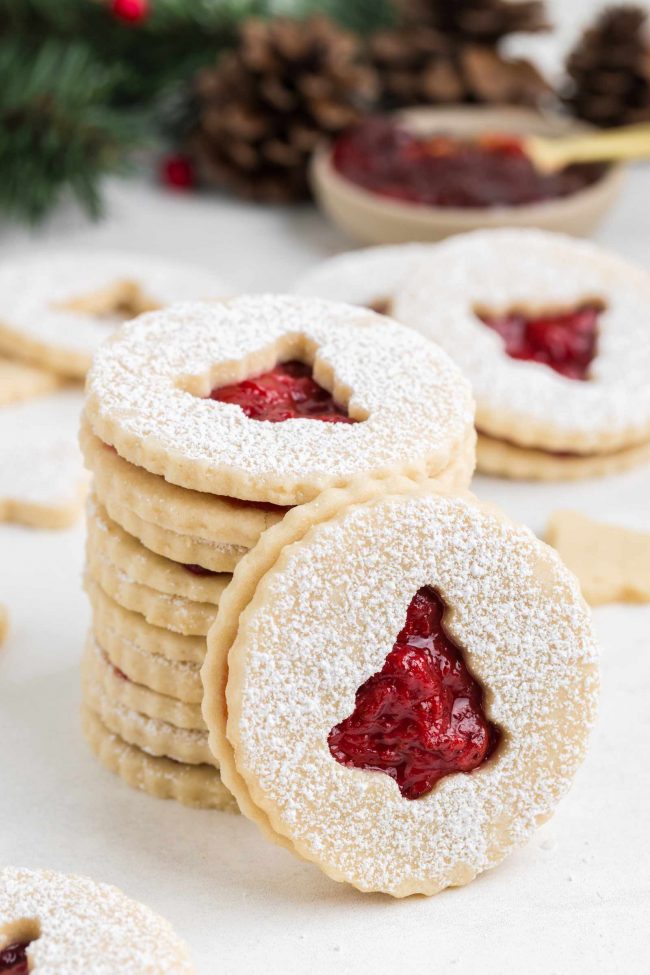
Ingredients
Here’s what you’ll need.
- Flour – I talk about the gluten-free option below.
- Almond flour – adds a nutty flavor and tender crumb. I also elaborate on this below.
- Unsalted butter – vital to the flavor! I don’t recommend using coconut oil (which isn’t a direct sub, anyway).
- Powdered sugar – this gives them their smooth texture. Don’t use granulated sugar instead.
- Egg yolks – no subs for these.
- Vanilla and almond extracts – you can use lemon extract + some zest, if you prefer. I actually have a lemon version I’ll share soon.
- Preserves or jam – you can use whatever flavor you’d like!
- Water and salt
I didn’t forget leavening. There isn’t any in this recipe.
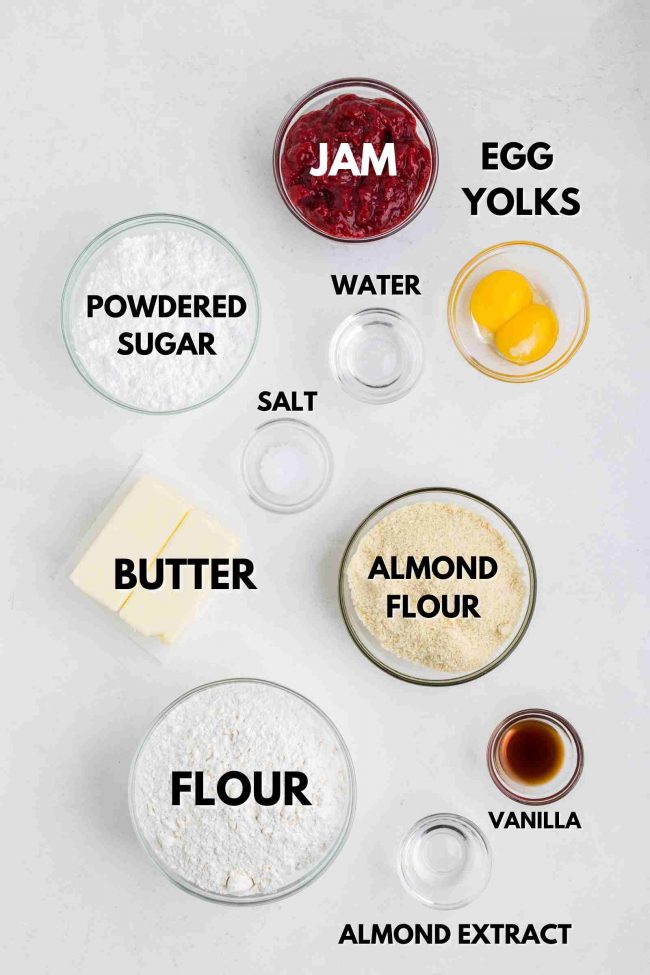
Almond flour vs. almond meal
Almond flour is made from blanched almonds (meaning the skins have been removed) that are finely ground into a soft, powdery texture. It’s commonly used in recipes that require a smooth, delicate finish, such as macarons, cakes and – Linzer cookies!
Almond meal is made from whole almonds, including the skins. It often has a speckled appearance due to the inclusion of almond skins and works best in recipes where texture isn’t as critical, like muffins or certain quick breads.
For recipes like Linzer cookies, almond flour is the preferred choice because its fine texture helps create the tender and delicate consistency that defines these cookies. If you used almond meal, your cookies would also be speckled with the skin of the almonds.
If you’re new to buying almond flour, don’t just grab something that says almond flour from the shelf and assume it’s the right stuff.

As an Amazon Associate, I earn from qualifying purchases. For more info, see my disclosure.
Bob’s Red Mill changed the name of their almond meal to Super-Fine Natural Almond Flour. It was previously called Natural Almond Meal.
Their almond flour is called Super-Fine Almond Flour. That’s what you want!
NOW Foods also sells “Raw Almond Flour” which is really almond meal.
Also, if you live outside of the US or Canada, make sure not to buy defatted/deoiled almond flour, which is very finely ground and powdery, almost like coconut flour. That doesn’t work the same as blanched finely ground almonds (which is the same as US almond flour).
What you likely need to buy is called “ground almonds” and not “almond flour” (which is the deoiled powdery stuff).
I know this is confusing. Here’s an example.
In Germany, I can buy “mandelmehl” which translates directly to “almond flour.” But this is actually defatted almond flour. Your baked goods would come out too dry with it.
What I need to buy here is called “blanchierte gemahlene Mandeln” which translates to “blanched ground almonds.”
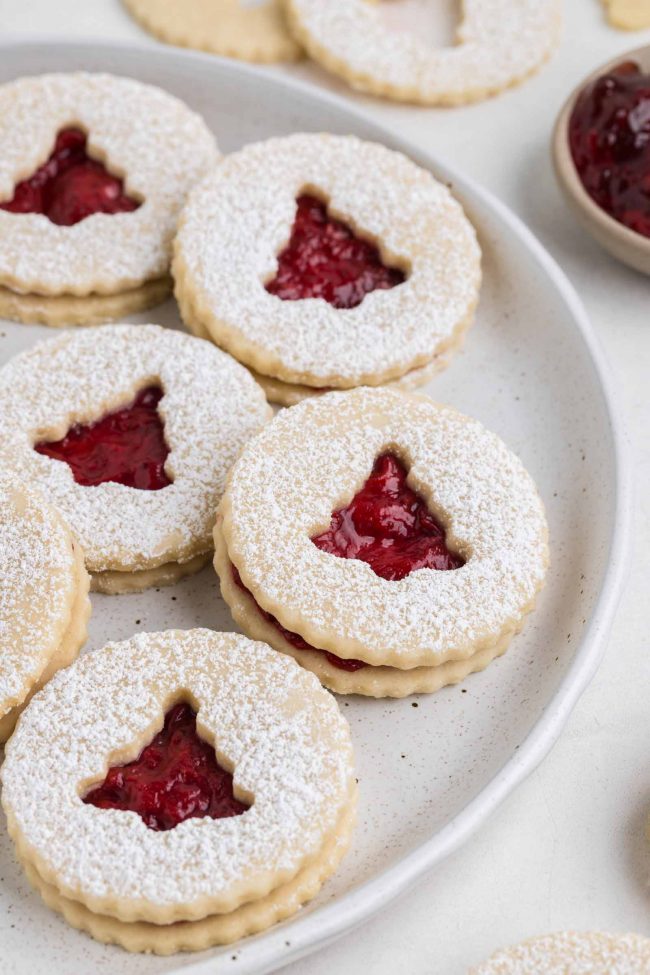
Can I use homemade almond flour?
Homemade almond flour tends to have a coarser texture and isn’t as finely ground as store-bought. The difference between finely ground almond flour and homemade is huge.
If you use it for this recipe, the cookies will spread excessively and turn out greasy. The edges of the cookies will also be lacy and fragile.
I say in other recipes that it’s fine to experiment if you don’t care what the results look like, but for these Linzer tart cookies, which are supposed to hold their shape, you must use finely ground store-bought blanched almond flour.
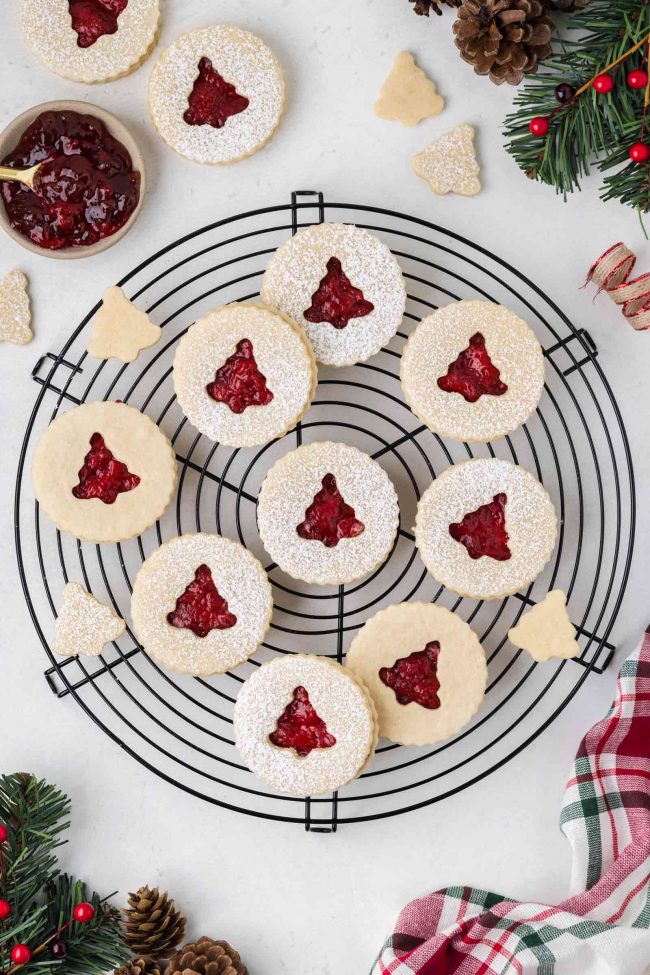
What are Linzer cookies?
Linzer cookies are a smaller, cookie version of the traditional Austrian Linzer torte, one of the oldest known cakes in the world. Named after the city of Linz, the torte features a buttery almond crust filled with jam and topped with a lattice crust.
Linzer cookies capture the essence of the torte in a handheld treat, featuring two almond-flavored cookies sandwiched together with jam and dusted with powdered sugar.
Traditionally, Linzer cookies are made with almond flour (or hazelnut meal, depending on the region) and filled with raspberry or red currant jam, but modern versions often incorporate other flavors like strawberry, apricot, or even chocolate.
Their signature look comes from the top cookie, which has a cut-out shape revealing the colorful jam underneath. Common cut-out shapes include hearts, stars, or circles, adding a festive touch to the cookies.
They’re perfect for holidays, special occasions, or any time you want to indulge in a delicate, sophisticated dessert. Despite their intricate appearance, they’re surprisingly easy to make with the right tools and techniques. But they do require quite a bit of time.
Traditional Linzer cookies do sometimes include spices like cinnamon, nutmeg, or cloves, particularly in older or regional recipes. However, many modern recipes omit spices to let the almond and butter flavors shine. I’ve tried a few traditional Linzer cookies (I live 50 minutes from Austria!) with spices and wasn’t a fan. They were, in my opinion, a bit strange.
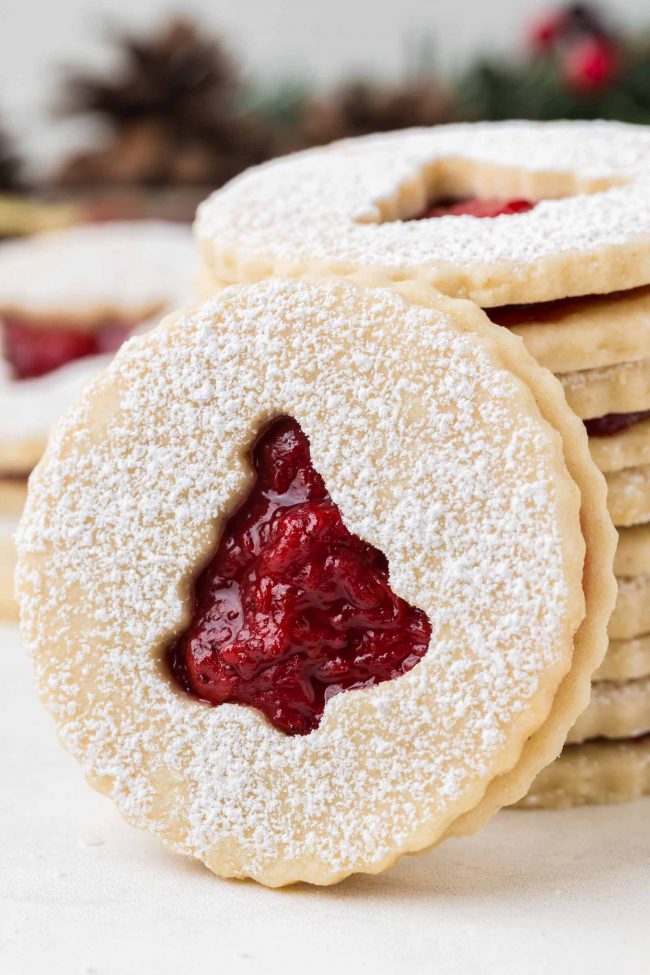
“Almond extract isn’t traditional!”
Indeed it’s not. Traditional Austrian Linzer cookies typically don’t include almond extract. The nutty flavor in these cookies traditionally comes from ground hazelnuts or almonds in the dough rather than additional flavorings.
However, modern variations sometimes incorporate a small amount of almond extract to enhance the nutty flavor, especially when using almond flour. This adaptation is more common in recipes outside Austria and is a matter of personal preference rather than tradition.
If you want to stick to a traditional approach, omit the almond extract. But to be honest, I find Linzer cookies a bit boring without the extract. I wouldn’t make them without it.
You know what else isn’t traditional? Vanilla extract. But I still included it. 🙈
I shared these cookies with many Germans, and everyone said they preferred the almond and vanilla extract version to the no extract + cinnamon version.
But if you want to be authentic, then add 1/2 teaspoon of cinnamon and use water in place of the extracts.
How to make them
Making Linzer cookies involves three main steps: preparing the dough, baking the cookies, and assembling them.
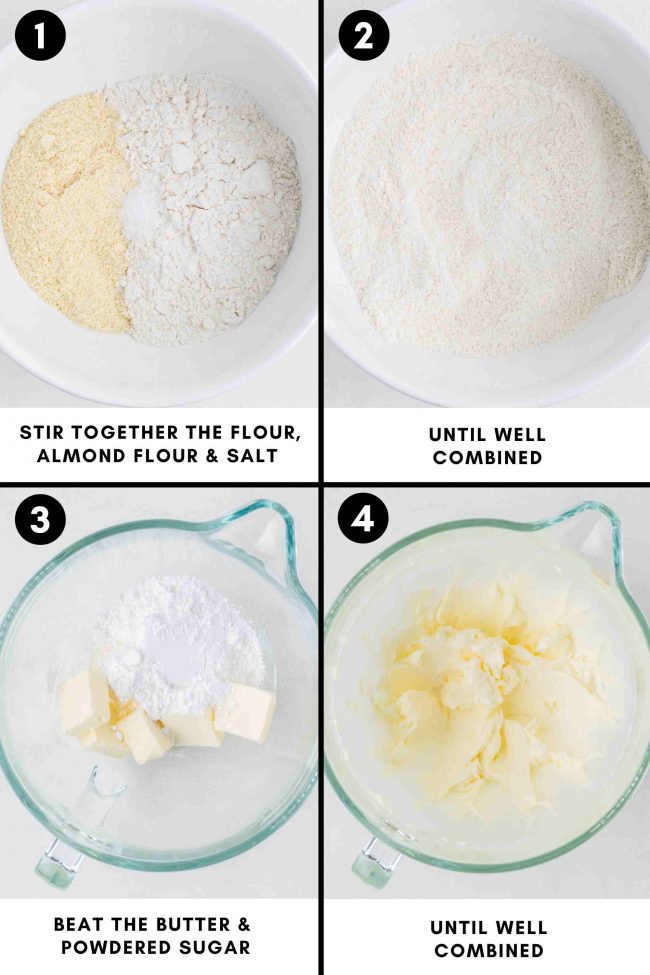
I see other people using 1/2 teaspoon or 1 teaspoon of jam per cookie, but I didn’t like the cookies when they had so little jam. So I used 1 1/2 teaspoons.
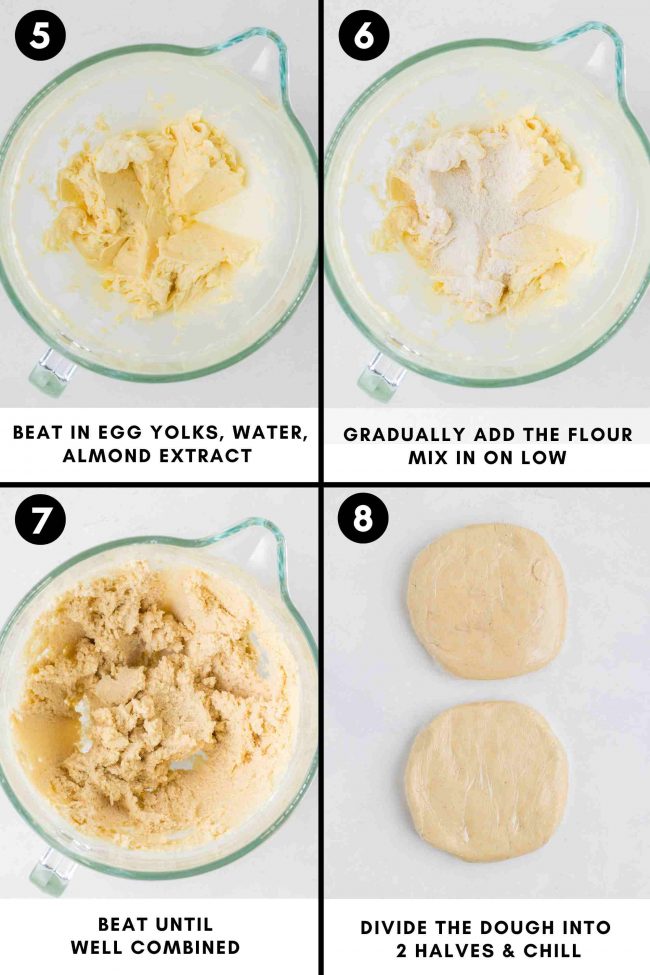
Try out what’s best for you. Maybe you only want 1/2 teaspoon. The amount of jam called for in the recipe is enough for using 1 1/2 teaspoons for 28 cookies.
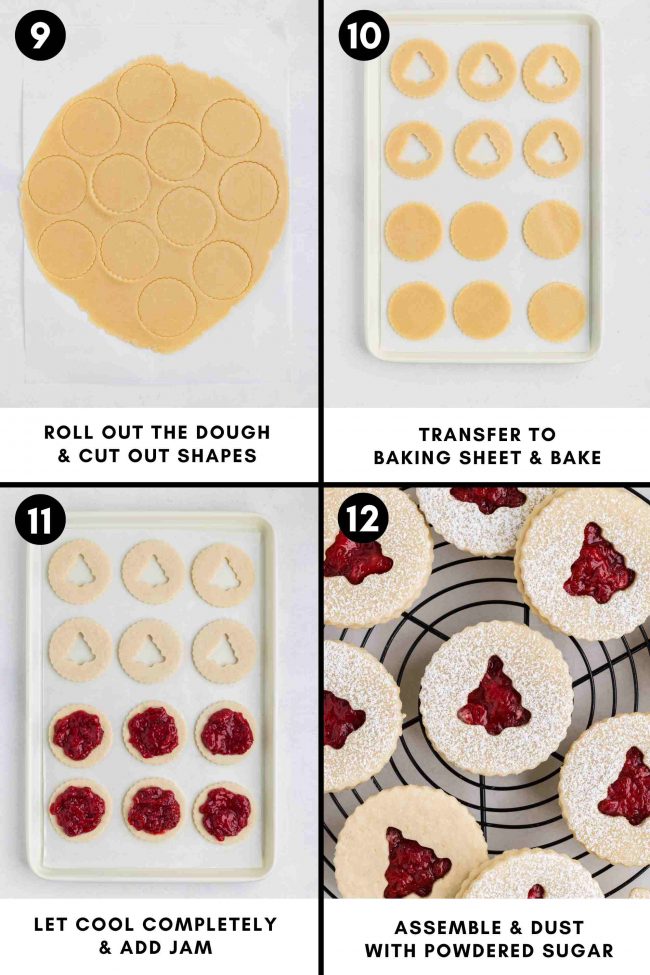
Yield and cookie cutters
This is going to vary depending on your cookie cutters and exactly how thick you roll the dough out.
I got 28 assembled Linzer cookies with a 2.25″ (5.7 cm) cutter. When using a 2.75″ (7 cm) cutter, that’s 23 assembled cookies.
Wilton’s Linzer Cookie Cutters are a bit bigger at 3″ (7.6 cm). They look really nice, but I think they’re a bit big for holiday parties when there will be several cookies and other desserts to choose from.
You don’t need special Linzer cookie cutters, though. You can mix and match whatever cutters you already have, provided that you have some rather small Christmas trees, stars, hearts or whatever design you’d like in the middle.
Tips
To ensure your Linzer cookies turn out beautifully, follow these tips.
- Chill the dough for at least 2 hours to make it easier to handle.
- Roll the dough between parchment paper to prevent sticking.
- When you cut out the shapes and you try to remove them – if they’re not easy to remove or at all sticky, place the dough (which is now between 2 sheets of parchment paper) onto a baking sheet and place in the fridge for about 20 minutes to firm up or place in the freezer for 5-10 minutes. They’ll then be very easy to remove!
- Use a light touch when assembling the cookies to avoid breaking them. I might have broken a few cookies the first time I made them.

Troubleshooting
If you encounter issues while making Linzer cookies, here are some solutions.
- Cookies are too crumbly – add a tiny bit of water to the dough to bring it together.
- Dough is sticky – chill it for an additional 30 minutes before rolling.
- Cookies spread too much – ensure the dough is properly chilled before baking.
- Jam seeps out – use a thicker jam or apply less filling.
How to make ahead, store and freeze
- Dough – wrap the discs tightly in plastic wrap, place in a Ziploc and refrigerate for up to 3 days or freeze for up to a month.
- Baked unassembled cookies – store in an airtight container for up to 5 days. Assemble them with jam closer to serving to ensure they stay fresh. For longer storage, freeze the unassembled cookies. Place parchment paper between layers to prevent sticking, and store them in an airtight container for up to three months. Defrost at room temperature before filling with jam.
- Assembled cookies – store in an airtight container in the refrigerator for up to 4 days or freeze for up to 3 months. If you know you’ll be freezing the cookies to serve later, then only add the powdered sugar after they’ve completely defrosted.
On every Linzer cookie recipe I looked at, they say to keep them at room temp for up to 3 or 5 days. Maybe I’m the weird one here, but do people normally leave jam sitting out on the countertop for 3 to 5 days?
I’ll leave treats out at room temp with baked jam in them, like these Raspberry Thumbprint Cookies or Berry Bars, but you are just slathering plain jam onto a cookie for this recipe. It’s not baked.
Would you put jam on a piece of toast, leave it out for 5 days, and then be fine with eating the jam? Some sources say that it’s so little jam and the cookies are dry, so it’s fine.
Maybe it is fine, and like I said, maybe I’m the odd one here, but this sounds absolutely bonkers to me.
So I keep mine refrigerated.

Can I send these in the mail?
I often get this question on Christmas cookie recipes. The answer is a most definite no.
First, there’s that whole jam issue I went on and on about above.
Second, they’re fragile unless they’re chilled. At room temp, they’re crumbly and delicate.
Once chilled, they’re much sturdier. You can easily transport the chilled ones, but if you stack them, the powdered sugar will get messed up.
So you can either just layer the Linzer tarts on top of other cookies, or stack them and add the powdered sugar whenever you arrive to your destination.
These Almond Paste Cookies, or German almond horns (Mandelhörnchen), are a MUCH better choice if you want to send cookies in the mail!
They stay fresh for weeks and are sturdy enough to not fall apart in the mail.
They’re still more work than a normal cookie recipe, but less hassle than these Linzer cookies.
My very favorite option would be these Chocolate Gingerbread Cookies. They hold up great, are sturdy, and everyone flips for them. And they’re super quick and easy.
I think I ended up making 9 batches last Christmas. I didn’t have time to fuss with anything like these Linzer cookies.
I will say that these Linzer cookies are a fun project if you’ve got some spare time on your hands or want to involve kids in a creative kitchen activity.
They’re not a great choice if you’re in a hurry. Just trying to be honest. 🙂

Filling options
I (and my photographer) used my Strawberry Preserves Recipe. We still had some left over from when we made the preserves recipe, and it was the perfect use. It suits these cookies perfectly!
Raspberry or red currant jam are the traditional options, but you can use any type of jam or preserves that you’d like.
This Peach Jam would be nice and summery and goes great with the almond extract should you choose to be a rebel and use it. 😉
Nutella or homemade chocolate hazelnut spreads are also delicious options. I thought it might be odd with the almond extract, but it wasn’t at all.
Gluten-free option
These cookies came out looking exactly like the version in the photos when I used King Arthur Flour Gluten-free Measure for Measure Flour.
It could be that other brands will yield sandier and more crumbly cookies that spread too much. So I’d stick to that brand, if possible!
If you feel like experimenting, you absolutely must use a blend that’s meant as a direct sub for all-purpose flour. Not almond, coconut, oat, etc. flours.
I hope you’ll enjoy these Linzer cookies! If you try them out, I’d love to hear your thoughts below in the comments. Thanks! 🙂
❀
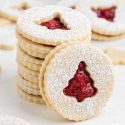
- Prep Time:
- Cook Time:
- Ready in:
- Yield: 28
Ingredients
- 2 1/2 cups (312 grams) all-purpose flour or for gluten-free, use King Arthur Flour Gluten-free Measure for Measure Flour
- 1 cup (100 grams) finely ground blanched almond flour
- 1/2 teaspoon salt
- 1 cup (225 grams) unsalted butter, room temperature
- 1 cup (120 grams) powdered sugar, plus extra for dusting
- 2 large egg yolks, room temperature
- 2 1/2 teaspoons vanilla extract
- 1 1/2 teaspoons almond extract
- 1 tablespoon water
- up to 3/4 cup + 2 tablespoons jam or preserves
Directions
- In a large mixing bowl, stir together the flour, almond flour and salt. Set aside.
- In the bowl of a stand mixer fitted with the paddle attachment, beat the butter and powdered sugar at medium speed until well combined.
- Turn the speed down to low and add the egg yolks, vanilla extract, almond extract and water. Beat on low until combined.
- Gradually add the flour mix in on low and continue beating on low, just until combined.
- Divide the dough into two halves (415 grams each) and wrap each one into a disc.
- Chill for 2 hours or up to 3 days. The dough is easier to work with if you let it chill 8+ hours.
- Preheat the oven to 350 °F (175 °C).
- Line a large cookie sheet with a piece of parchment paper.
- Roll one of the discs out onto a non-floured piece of parchment paper. You can place either plastic wrap (that the piece the disc was rolled in) or parchment paper on top of the dough to create a barrier between the dough and the rolling pin.
- Roll the dough out to be about 1/8” (.3 cm) thick.
- Use a round cookie cutter (mine was 2.25” (5.7 cm)) to cut out solid circles and circles with a cut-out (you want the same number of both). The disc of dough was 415 grams and each set of circle + circle with a cut-out was 29 grams, so with this disc of dough, you should be able to make 14 Linzer cookies (so that’s 14 solid circles + 14 circles with a cut-out).
- If the dough is easy to work with, you can already transfer the circles on the parchment-lined cookie sheet. They only spread a tiny amount so they can be pretty close together. If it’s at all sticky, place the piece of parchment paper and the rolled-out dough onto a baking sheet and place in the fridge for about 20 minutes to firm up again, or place in the freezer for 5-10 minutes. Then transfer to the baking sheet.
- Bake for 7-10 minutes or until the edges have very lightly browned.
- Let cool for about 10 minutes on the cookie sheet, and then transfer the cookies to a cooling rack. Let cool completely, another 20-30 minutes. They can’t be warm at all or the powdered sugar will dissolve.
- Roll out the rest of the dough from the first disc and bake the rest of those cookies. You’ll probably need to chill the dough since it’s been sitting out for a bit.
- Then do the other disc of dough.
- At this point, everyone else dusts the tops of the cut-out cookies with powdered sugar. But then you have to be very, very careful handling the cookies so you don’t mess up the powdered sugar. I tested out dusting the whole assembled cookie with powdered sugar and the powdered sugar immediately dissolved on top of the jam, and you couldn’t see it at all. I suggest experimenting with both methods and seeing which one you prefer.
- Spread about 1 1/2 teaspoons of strawberry preserves into the center of one of the circles. You can do as little as 1/2 teaspoon, if you prefer. You have to be careful with them because they break easily.
- Carefully top with one of the cut-out cookies.
- They’re crumbly at this point, but if you refrigerate them for 8+ hours, the cookies absorb some of the preserves and become chewy. The powdered sugar remained perfect looking.
- Store in an airtight container in the fridge for up to 4 days or freeze for up to 3 months. If you know you’re going to freeze them, add the powered sugar only after defrosting.
Make the dough:
Bake the cookies:
Assemble the cookies:
Notes
- I see other people using 1/2 teaspoon or 1 teaspoon of jam per cookie, but I didn’t like them with so little. So I used 1 1/2 teaspoons. If you make 28 cookies, that means 14 tablespoons of jam. If you only want to use 1 teaspoon, then you’ll need 7 tablespoons.
- If you prefer an authentic version, use water in place of the almond and vanilla extracts and add 1/2 teaspoon of cinnamon. Raspberry or red currant jams are the traditional jam flavors used. I’ve made the authentic version (and eaten the authentic version many times in Austria) and personally much, much prefer the almond extract, vanilla extract and no cinnamon version. I live less than an hour from Austria and the many Germans who tasted these cookies agreed with me. But you’re, of course, welcome to make the cinnamon version if you want to be authentic. 🙂

